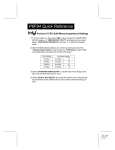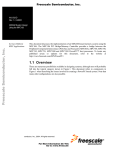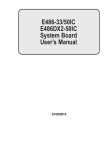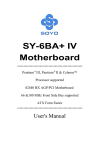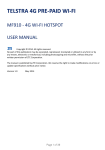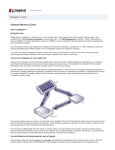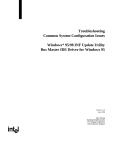Download Pentium Pro Mainboard USER`S MANUAL
Transcript
Table of Contents i Pentium Pro Mainboard USER’S MANUAL Table of Contents Chapter 1 System Board Overview Specifications .....................................................................1-1 Component Placement ........................................................1-2 The system block diagram ..................................................1-3 Chapter 2 Hardware Setup Precautions.........................................................................2-1 Connectors.........................................................................2-1 Jumper Switches.................................................................2-5 Installation of CPU.............................................................2-7 Installation of Memory .......................................................2-7 Chapter 3 Award BIOS Setup CPU SOFT MENU ............................................................3-3 Standard CMOS Setup Menu .............................................3-4 BIOS Features Setup Menu................................................3-6 Chipset Features Setup Menu .............................................3-8 Power Management Setup..................................................3-9 PCI & Onboard I/O Setup ................................................3-12 Load BIOS Defaults.........................................................3-14 Load Setup Defaults.........................................................3-14 Setting Password..............................................................3-15 IDE HDD Auto Detection................................................3-15 Standard types of hard disks .............................................3-16 Part Number: MN-094-2A1-01 Rev:1.01 ii Chapter 4 Table of Contents Bus Master IDE Driver System Board Overview 1-1 Chapter 1 System Board Overview The mainboard is designed for the new generation CPU. It supports the Intel CPU SLOT1(Pentium Pro, PentiumII ..), memory up to 1GB, super I/O, and Green PC functions. The mainboard provide high performance for the server system and meet the necessary of the desktop system for Multi-Media in the future. Specifications 1. CPU: 2. Chipset: 3. Memory(DRAM): 4. On board IDE: 5. On board FDC: 6. On board Fast I/O: 7. I/O slots: 8. BIOS: 9. Dimension: Supports Intel Pentium Pro 150~200 MHz, PentiumII 233~266 MHz Intel 82440 FX chipset Four 72PIN SIMM modules Two 168PIN DIMM modules Supports 8MB to 1GB memory capacity Supports EDO and FP DRAM type Two E-IDE channels Supports up to 4 hard devices Supports two floppy disk drivers up to 2.88MB One EPP/ECP parallel port (IEEE 1284 Compliant) Two high speed 16550A Compliant UARTs Supports Infrared – IrDA(HPSIR) and Amplitude Shift Keyed IR(ASKIR) Supports “PCI Bus master IDE controller” to reduce the work load of the CPU Supports two Universal Serial Bus (USB) interface Supports one PS/2 mouse connector Four 32-bit PCI slots, three 16-bit ISA slots Award Plug and Play BIOS ATX form factor 245 x 305 mm 1-2 Chapter 1 Component Placement Figure 1-1 Component Locations System Board Overview 1-3 The System block diagram VRM 8.1 CPU-SLOT1 Host BUS Control Address Data Addr PMC 82441FX Main Memory (DRAM) Cntrl Data DBX 82442FX PCI BUS Control PCI Address/Data USB1 PIIX3 SLOT(s) PCI IDE HEADER USB2 ISA BUS ISA SLOT(s) Buffer KBC RTC AIP 37C669 (M5113) Serial LPT IrDA X BUS Flash BIOS FDC 1-4 Chapter 1 Hardware Setup 2-1 Chapter 2 Hardware Setup This chapter describes the mainboard’s connectors and how to set the mainboard’s jumpers. Precautions You should take the following precautions before you begin working with the motherboard and its components: l Turn off the mainboard’s power, and unplug the power cord. l Unplug all cables connect the mainboard to any external devices. Caution: Make sure you first turn off all power to the system before attaching components to the mainboard. Connectors You attach system components and case devices to the mainboard’s connectors. A description of each connector and its pin assignments follows. Refer to Figure 1-1 for connector location on the mainboard. PN2(Pin 4-5-6-7) - Speaker Connector Attach the system speaker to connector PN2. Pin 4 5 6 7 Assignment Speaker data Ground Ground +5VDC 2-2 Chapter 2 PN2(Pin 1-2) - Hardware Reset Connector Attach the cable from the case’s Reset switch to this connector. Press and hold the reset button for at least one second to reset the system. Pin 1 2 Assignment Reset input Ground PN1(Pin 13-14) - Hardware Suspend Switch (SMI Switch) Attach the cable from the case’s suspend switch (if exist) to this switch. Use this switch to enable/disable the power management function by hardware. Pin 13 14 Assignment Suspend signal Ground PN1(Pin 1-2-3-4-5) - Keylock and Power LED Connector Attach the case’s keylock to connector. Pin 1 2 3 4 5 Assignment +5VDC No connection Ground Keylock inhibit signal Ground PN1(Pin 7-8) - HDD LED Connector Attach the cable from the case’s HDD LED to this connector. Pin 7 8 Assignment LED power HDD active Hardware Setup 2-3 MOUSE - PS/2 Mouse Connector Attach a PS/2 mouse to this 6-pins Din-connector. Pin 1 2 3 4 5 6 Assignment Mouse data No connection Ground +5VDC Mouse clock No connection KB - PS/2 Keyboard Connector Attach a keyboard to this 6-pins Din-connector. Pin 1 2 3 4 5 6 Assignment Keyboard data No connection Ground +5VDC Keyboard clock No connection 2-4 Chapter 2 ATX PWR - ATX Power input Connector Caution: If power supply connectors are not properly attached to ATX PWR, the power supply or add-on cards may be damaged. Attach the connectors from the power supply to ATX PWR. Pin 1 2 3 4 5 6 7 8 9 10 Assignment +3.3V +3.3V Ground +5V Pin 11 12 13 14 Ground +5V Ground Powergood +5V +12V 15 16 17 18 19 20 FAN1, FAN2 - DC-FAN Power Connector Pin 1 2 3 Assignment Ground +12V Ground IR - IR Connector(Infrared) Pin 1 2 3 4 5 Assignment +5V No connection IR_RX Ground IR_TX Assignment +3.3V -12V Ground ON/OFF control signal Ground Ground Ground -5V +5V +5V Hardware Setup 2-5 I/O port connectors Name No. of pins IDE1 40 IDE channel 1 connector IDE2 40 IDE channel 2 connector FDC 34 Floppy disk connector LPT 25 Parallel port connector COM1 9 Serial port COM1 connector COM2 9 Serial port COM2 connector USB 8 Universal serial Bus Notes: Description *IDE1, IDE2 are high performance PCI IDE connectors. Up to four IDE interface devices are supported. 2-6 Chapter 2 Jumper Switches You set jumper switches on the mainboard to configure various hardware options. See Figure 1-1 for jumper locations. Throughout this section the following symbols are used to indicate jumper settings. For 3-pin jumpers, the symbols below are used: Short Pins 1 and 2 with a jumper cap. Short Pins 2 and 3 with a jumper cap. For 2-pins jumpers, the following symbols are used: Place the jumper cap over the two pins of the jumper to Short the jumper. Remove the jumper cap to Open the jumper cap. Note: To avoid losing jumper caps, attach the removed jumper cap to one of the jumper pins. Hardware Setup 2-7 CCMOS - CMOS Discharge Jumper Jumper CCMOS discharge CMOS memory. When you install the mainboard, make sure this jumper is set for Normal Operation(1-2). See the jumper as below. Setting CCMOS Normal Operation (Default) Discharge CMOS JR1 - ATX Power Power-On Setting Low active High active (Default) JR1 2-8 Chapter 2 JD1 - DIMM Power Select Setting JD1 5V 3.3V (Default) Installation of CPU The mainboard is equipped with a CPU-SLOT1 slot to accommodate the KP6 CPU card and Intel PentiumII CPU or above. The default clock rate setting for KP6 CPU card is 150MHz and PentiumII CPU is 233MHz depend on autodetect from BIOS. But there is an advantage way for setup menu. The details please refer the chapter 3 “Award BIOS Setup”. Hardware Setup 2-9 Installation of Memory The mainboard provides four 72-pin SIMM and two 168-pin DIMM sites for memory expansion. The SIMM socket supports 1Mx32(4MB), 2Mx32(8MB), 4Mx32(16MB), 8Mx32(32MB), 16Mx32(64MB), and 32Mx32(128MB) single side or double side SIMM modules. The DIMM socket supports 1Mx64(8MB), 2Mx64(16MB), 4Mx64(32MB), 8Mx64(64MB), 16Mx64(128MB), and 32Mx64(256MB) or double side DIMM modules. Minimum memory size is 8MB and Maximum memory size will be 1GB. There are four banks of Memory on the system board. In order to create a memory array certain rules must be followed. The following set of rules allows for optimum configurations. l SIMM modules must be populated in pairs; the memory array is 64 or 72 bits wide. (Without parity or with parity) l Those modules can populated in any order. l SIMM modules pairs need to populated with the same densities, single or double. For example, Bank0 must populated with identical densities. However Bank1 can be populated with different densities than Bank0. l The asymmetrical DRAM modules should be the same type in the same bank. l The EDO DRAM modules can mixed with standard page mode DRAM module, but must not be in the same bank. For example, Bank0 can be populated with EDO DRAM module. Each bank will be optimized for that type of memory according to the BIOS setup. The following is the valid memory configuration: Bank Bank0 (SIMM1, 2) Bank1 (SIMM3, 4) Bank2 (DIMM1) Bank3 (DIMM2) Memory Module 4MB, 8MB, 16MB, 32MB, 64MB, 128MB 4MB, 8MB, 16MB, 32MB, 64MB, 128MB 8MB,16MB,32MB,64MB, 128MB, 256MB 8MB,16MB,32MB,64MB, 128MB, 256MB Total System Memory x2 Total Memory 8MB ~ 256MB x2 8MB ~ 256MB x1 8MB ~ 256MB x1 8MB ~ 256MB +)= 8MB ~ 1GB 2-10 Chapter 2 Award BIOS Setup 3-1 Chapter 3 Award BIOS Setup All personal computer use a BIOS, or Basic Input / Output system, to provide control for the hardware functions. When system is powered on or reset, the CPU is reset and BIOS will do the following: l l l l l l l l Self-test on CPU. Verify ROM BIOS checksum. Verify CMOS configuration chip. Initialize timer. Initialize DMA controller. Verify system memory and cache memory. Install all BIOS function call utilities. Verify/initialize all system configurations, like keyboard, floppy drive, hard disk, initialize EGA or VGA if there is any. l Hook to the add-in BIOS (include NCR PCI SCSI BIOS) or expansion BIOS to perform initialization and driver link to the system. Award’s BIOS ROM has a built-in setup program that allows users to modify the basic system configuration. This type of information is stored in batterybacked RAM so that the setup information is retained when the power is turned off. When the system is powered on or reset, the Award BIOS will display a copyright message on the screen, then the BIOS will perform the system diagnostics test and initialization. When all of the above tests have been passed, the message: “TO ENTER SETUP BEFORE BOOT PRESS CTRL-ALT-ESC OR DEL KEY” 3-2 Chapter 3 is display. If the [Del] key or Ctrl-Alt-Esc is pressed, the screen will be cleared and then the following message will be shown: ROM PCI/ISA BIOS (XXXXXXXX) CMOS SETUP UTILITY AWARD SOFTWARE, INC. !! CPU SOFT MENU !! LOAD BIOS DEFAULTS STANDARD CMOS SETUP LOAD SETUP DEFAULTS BIOS FEATURES SETUP PASSWORD SETTING CHIPSET FEATURES SETUP IDE HDD AUTO DETECTION POWER MANAGEMENT SETUP SAVE & EXIT SETUP PCI & ONBOARD I/O SETUP EXIT WITHOUT SAVING Esc: Quit ↓↑→←: Select Item F10: Save & Exit Setup (Shift)F2: Change Color Description of each function Figure 3-1 Main Menu Award BIOS Setup 3-3 CPU SOFT MENU The CPU SOFT MENU is for setting CPU parameter. User can change CPU setting by software easily. In each item press the <F1> key, which will display the available option. ROM PCI/ISA BIOS (XXXXXXXX) !! CPU SOFT MENU !! AWARD SOFTWARE, INC. Intel Pentium Pro - Turbo Frequency : 150 : Disabled Esc: Quit ↑↓→←: Select Item F1: Help PU/PD/+/-: Modify F5: Old Values (Shift)F2: Color F6: Load BIOS Defaults F7: Load Setup Defaults Figure 3-2 !! CPU SOFT MENU !! Intel Pentium Pro Available item as below: 150 ⇒ 166 ⇒ 180 ⇒ 200 ⇒ …… ◊ Turbo Frequency: If external clocks support turbo frequency then screen will display this item. The meaning of the turbo frequency is external clock frequency, that can improve the system performance. ⇒ Disable: CPU external clock is normal frequency. ⇒ Enable: CPU external clock is turbo frequency. Note: Disable turbo mode is recommended. ⇒ 3-4 Chapter 3 Standard CMOS Setup Menu The items in Standard CMOS Setup Menu are divided into several categories. Each category includes none, one, or more than one setup items. Use the arrow keys to highlight the item and then use the <PgUp> or <PgDn> keys to select the value you want in each item. Date (mm:dd:yy) : Wed, Apr 21 1993 Time (hh:mm:ss) : 14:53:31 HARDS DISK Primary Master Primary Slave Secondary Master Secondary Slave Type : None : None : None : None Size CYLs HEAD PRECOMP LANDZ SECTOR MODE 0 0 0 0 0 0 0 0 0 0 0 0 0 0 0 0 0 0 0 0 0 0 ------------------------- Drive A: 1.44M, 3.5 in. Drive B: None Base Memory: 640K Extended Memory: 3328K Expanded Memory: 0K Other Memory: 128K Total Memory: 4096K Floppy 3 Mode Support: Disable Video : EGA/VGA Halt On: All, But Keyboard Esc: Quit ↓↑→←: Select Item PU/PD/+/-: Modify F1: Help (Shift)F2: Change Color F3: Toggle Calendar Figure 3-3 Standard CMOS Setup Menu The setup program is completely menu-driven: 1. Use arrow keys to select entry of Data, Time, Hard Disk, Floppy, Display, and Keyboard. 2. Use PgUp/PgDn key to modify the options of each entry. 3. Use Esc to exit. Hard Disk size selection The Award BIOS supports three HDD modes: NORMAL, LBA and LARGE. NORMAL mode: The maximum HDD size supported by the NORMAL mode is 528 Megabytes. Award BIOS Setup 3-5 LBA mode: Logical Block Addressing mode is a new HDD accessing method designed to overcome the 528Megabytes limitation. The number of cylinders, heads, and sectors shown in setup may not be the number physically contained in the HDD. During HDD accessing the IDE controller will transform the logical address described by cylinder, head, and sector number into its own physical address inside the HDD. The maximum HDD size supported by the LBA mode is 8.4Gigabytes. LARGE mode: Some IDE HDDs contain more than 1024 cylinders without LBA supports. This access mode tricks DOS (or other OS) that the number of cylinders is less than 1024 by dividing it by 2. At the same time, the number of heads is Multiplied by 2. The maximum HDD size supported by LARGE mode is 1 Gigabytes. Floppy 3 mode support This is the Japanese standard floppy drive. The standard stores 1.2MB in a 3.5” diskette. 3-6 Chapter 3 BIOS Features Setup Menu The BIOS Features setup program is equipped with a series of help screens accessed by the <F1> key, which will display the available options for a particular configuration feature and special help for some of the options. If you don’t really understand the meanings of each item, please don’t change the following default values. ROM PCI/ISA BIOS (XXXXXXXX) BIOS FEATURES SETUP AWARD SOFTWARE, INC. Virus Warning CPU Internal Cache External Cache Quick Power on Self Test Boot Sequence Swap Floppy Drive Boot Up Floppy Seek Boot Up Numlock Status IDE HDD Block Mode Typematic Rate Setting Typematic Rate (Chars/Sec) Typematic Delay (Msec) Security Option PCI/VGA Palette Snoop : Disabled : Enabled : Enabled : Enabled : A, C : Disabled : Disabled : On : Enabled : Enabled : 30 : 250 : Setup : Disabled Esc: Quit F1: Help F5: Old Values F6: Load BIOS Defaults F7: Load Setup Defaults Figure 3-4 : Enabled : Disabled : Disabled : Disabled : Disabled : Disabled : Disabled Video BIOS shadow C8000-CBFFF Shadow CC000-CFFFF Shadow D0000-D3FFF Shadow D40000D7FFF Shadow D8000-DBFFF Shadow DC000-DFFFF Shadow ↑↓→←: Select Item PU/PD/+/-: Modify (Shift)F2: Color BIOS Feature Setup A short description of screen items follows: Virus Warning Enable this option and a warning message appears when there is any attempt to access the boot sector or hard disk partition table. CPU Internal Cache This option enables/disables the CPU’s internal cache. (The Default setting is Enabled.) External Cache This option enables/disables the external cache memory. (The Default setting is Enabled.) Quick Power On Self Test Enabled provides a fast POST at boot-up. Boot Sequence The system can be boot from drive A:, or C:. There are two sequences can be choose: “A, C”, “C, A”. Award BIOS Setup 3-7 Swap Floppy Drive Enabled changes the sequence of the A: and B: drives. (The Default setting is Disabled.) Boot Up Floppy Seek Enable this item and the BIOS searches for installed floppy disk drives to determine if they are 40 tracks (360K drive) or 80 tracks (720K, 1.2M, 1.44M, or 2.88M drives). Disable this item and the BIOS does not search for floppy drive type by track number. IDE HDD Block Mode This option enables/disables the IDE HDD Block Mode function. Older HDDs do not support this function. (The Default setting is Enabled.) Typematic Rate Setting Enable this option to adjust the keystroke repeat rate. Typematic Rate (Chars/Sec) Choose the rate a Character keeps repeating. Typematic Delay (Msec) Choose how long after you press a key that a character begins repeating. Security Option Choose Setup or System. Use this feature to prevent unauthorized system boot-up or use of BIOS Setup. “System” - Each time the system is booted the password prompt appears. “Setup” - If a password is set, the password prompt only appears if you attempt to enter the Setup program. PCI/VGA Palette Snoop Choose Enable or Disable. Used to alter VGA palette setting while graphics pass through feature connector of PCI VGA card and processed by MPEG card. Video or Adapter BIOS Shadow BIOS shadow copies BIOS code from slower ROM to faster RAM. BIOS can then execute from RAM. 3-8 Chapter 3 Chipset Features Setup Menu The Chipset Features Setup Menu are used to change the parameter of the chipset internal registers. All of these parameters are hardware dependent. A wrong parameters may be caused the mainboard out of order. Run the Chipset Features Setup as follows. 1. Choose “CHIPSET FEATURES SETUP” from the Main Menu and following screen appears. ROM PCI/ISA BIOS (XXXXXXXX) CHIPSET FEATURES SETUP AWARD SOFTWARE, INC. Auto Configuration DRAM Speed Selection DRAM RAS# Precharge Time MA Additional Wait State RAS# to CAS# Delay DRAM Read Burst (B/E/F) DRAM Write Burst (B/E/F) ISA Bus Clock : Enabled : 60 ns :4 : Enabled : Enabled : x2/2/3 : x3/3/3 : PCICLK/3 DRAM Refresh Queue DRAM RAS Only Refresh DRAM ECC/PARITY Select Fast Dram Refresh Read-Around-Write Combine PCI Burst Write Combine : Enabled : Disabled : Disabled : Disabled : Enabled : Enabled PCI-To-DRAM Pipeline CPU-To-PCI Write Post CPU-To-PCI IDE Posting System BIOS Cacheable Video RAM Cacheable : Enabled : Enabled : Enabled : Disabled : Disabled Figure 3-5 Note: Memory Hole At 15M-16M 8 Bit I/O Recovery Time 16 Bit I/O Recovery Time Memory Hole At 15M-16M DRAM Fast Leadoff Passive Release Delayed Transaction Esc: Quit F1: Help F5: Old Values F6: Load BIOS Defaults F7: Load Setup Defaults :1 :1 : Disabled : Disabled : Enabled : Disabled ↑↓→←: Select Item PU/PD/+/-: Modify (Shift)F2: Color Chipset Feature Setup Menu Choose Enable or Disable (Default). Used to reserved memory addressing space for some special add-on-card that requires 1M bytes addressing space from 15 to 16M. 2. Use the arrow keys to move between items and select values. Modify selected fields using the PgUp/PgDn/+/- keys. 3. After you have finished with the Chipset Features Setup, press the <Esc> key and follow the screen instructions to save or disregard your new settings. Award BIOS Setup 3-9 Power Management Setup The Power Management Setup option lets you set the system’s power saving functions. 1. Choose “POWER MANAGEMENT SETUP” from the Main Menu. ROM PCI/ISA BIOS (XXXXXXXX) POWER MANAGEMENT SETUP AWARD SOFTWARE, INC. Power Management PM Control by APM Video Off Method Video Off Option Modem Use IRQ : User Define : Yes : V/H SYNC + Blank : Susp, stby à off : NA Doze Mode Standby Mode Suspend Mode HDD Power Down : Disable : Disable : Disable : Disable ** Wake Up Events In Doze & Standby ** IRQ 3 (Wake-Up Event) : ON IRQ 4 (Wake-Up Event) : ON IRQ 8 (Wake-Up Event) : OFF IRQ12 (Wake-Up Event) : ON ** Power Down & Resume Events ** : ON IRQ 3 (COM2) : ON IRQ 4 (COM1) : ON IRQ 5 (LPT2) : ON IRQ 6 (Floppy Disk) : ON IRQ 7 (LPT 1) : OFF IRQ 8 (RTC Alarm) : ON IRQ 9 (IRQ2 Redir) : ON IRQ 10 (Reserved) : ON IRQ 11 (Reserved) : ON IRQ 12 (PS/2 Mouse) IRQ 13 (Coprocessor) :ON IRQ 14 (IDE-1) : ON IRQ 15 (IDE-2) : ON Esc: Quit F1: Help F5: Old Values F6: Load BIOS Defaults F7: Load Setup Defaults ↑↓→←: Select Item PU/PD/+/-: Modify (Shift)F2: Color Figure 3-6 Power Management Setup Menu 2. Use the arrow keys to move between items and to select values. Modify the selected fields using the PgUp/PgDn/+/- keys. A short description of selected screen items follows: Power Management Options are as follows: User Define Set the power saving options by user. (Default) Disabled Disables the Green PC Features. Min Saving Doze = 1Hour Standby = 1Hour Suspend = 1Hour Max Saving Doze = 1Min Standby = 1Min Suspend = 1Min 3-10 Chapter 3 PM Control by APM Choose No or Yes (Default). APM stands for Advanced Power Management. “Yes” makes your power management more flexible. Video Off Method Choose DPMS, Blank screen, or V/H Sync + Blank (Default). With this item V/H SYNC is controlled by software. If you have a VGA card that is not compatible with the default option, switch to “Blank screen”, even though it consumes more power than “V/H SYNC + Blank”. If your VGA card and VGA monitor support VESA DPMS, switch the option to “DMPS”. Video Off Option Choose “Always On”, “All Modes Off” (Suspend, Standby and Doze mode), “Susp, Stby Off”(Default) and “Suspend Off”. This item shuts the video off when entering Doze mode, Standby mode or Suspend mode. Modem Use IRQ Setting “Modem Use IRQ” for the APM modem ring wake up function. HDD Power Down Choose a time interval from 1 to 15 minutes or “Disabled” (Default). When the set time has elapsed, the BIOS sends a command to the HDD to enter idle (sleep) mode, turning off the motor. This function is only valid for IDE HDDs that support power saving function. Doze Mode The default setting is Disabled. When the Power Management item is switched to “User Define” you can select a time interval from 1minute to 1 hour. When the set time elapses without activity the system enters Doze mode. If the idle time for all PM events IRQ 3-15 Activity is greater than the Doze mode, and the CPU speed slows down. If the Video Off Option is set to “All Modes Off”, the screen shuts off. Standby Mode The default setting is Disabled. When the Power Management item is switched to “User Define” you can select a time interval from 1 minute to 1 hour. When the set time elapses without activity the system enters Standby mode. Award BIOS Setup 3-11 If the idle time for all PM events is greater than the Standby time you set the system will enter Standby mode, and the CPU speed slows down. If the screen will shut off. Suspend Mode The default setting is Disabled. When the Power Management item is switched to “User Define” you can select a time interval from 1 minute to 1 hour. When the set time elapses without activity the system enters Suspend mode. If the idle time for all PM events is greater than the Suspend time you set the system will enter Suspend mode, and the CPU Internal frequency drops to 0 MHz. If the “Video Off Option” is set to “Suspend Off”, the screen will shut off. Wake-up Event “ON” - Wake up the system when IRQn signal received in the Doze & Standby mode. “OFF” - IRQn signal does not wake up the system, when the system is in the Doze & Standby mode. Power Down & Resume Events There are several Power Management events can be selected IRQ3-15 Activity. “ON” - Reset green timer whenever PM Events Activity. “OFF - Discard any PM Events Activity and continuously accumulate timer count down for green function. 3. After you have finished with the Power Management Setup, press the <Esc> key to return to the Main Menu. 3-12 Chapter 3 PCI & Onboard I/O Setup The PCI & Onboard I/O Setup option lets you assign INT#s, IRQs, I/O ports, and other hardware settings to the mainboard’s PCI slots and onboard I/O. ROM PCI/ISA BIOS (XXXXXXXX) POWER MANAGEMENT SETUP AWARD SOFTWARE, INC. Reset PnP Config Data PCI IRQ Actived By BIOS Auto-Config PCI IRQ - 1st Available IRQ - 2nd Available IRQ - 3rd Available IRQ - 4th Available IRQ : Disabled : Level : Disabled : 10 : 11 :9 :5 PCI IDE Card 2nd Channel PCI IDE Card IRQ Map to -Primary IDE INT# - Secondary IDE INT# : Enable : PCI-AUTO :A :B Onboard USB Controller Onboard IDE-1 Controller : Disabled : Enabled - Master Drive PIO Mode - Slave Drive PIO Mode Onboard IDE-2 Controller - Master Drive PIO mode - Slave Drive PIO mode : Auto : Auto : Enabled : Auto : Auto Figure 3-7 Onboard FDD Controller Onboard Serial Port 1 Onboard Serial Port 2 - Onboard IR Function - IR Duplex Mode Onboard Parallel Port - Parallel Port Mode - ECP Mode Use DMA Esc: Quit F1: Help F5: Old Values F6: Load BIOS Defaults F7: Load Setup Defaults : Enabled : 3F8/IRQ4 : 2F8/IRQ3 : IrDA : Half : 378/IRQ7 : ECP+EPP1.9 :3 ↑↓→←: Select Item PU/PD/+/-: Modify (Shift)F2: Color PCI Configuration Setup Menu Reset PnP Config Data If you want to clear ESCD data next time you boot up, and ask the BIOS to reset the settings for the Plug & Play ISA Card and PCI Card, select “Enabled”. But the next time you boot up, this option will automatically be set as “Disabled”. PCI PnP BIOS Auto-Config Choose Enabled (Default) or Disabled. If Enabled the BIOS will automatically assigns IRQ to the PCI INT#. If Disabled the PCI INT# will be assigned by the next setup item - “Xth Available IRQ”. Xth Available IRQ These categories select a IRQ for INT#. There are ten IRQs options (3, 4, 5, 7, 9, 10, 11, 12, 14, 15) for available IRQs. 1st Available IRQ means BIOS will assign this IRQ to first INT found on the PCI slots (the assignment sequence is slot1, 2, 3). Award BIOS Setup 3-13 PCI IDE Card 2nd Choose Disable or Enable (Default). If the 2nd channel Channel is not used on the PCI IDE card, switch the option to “Disable”. Or IRQ15 can not work on the ISA slots. PCI IDE Card IRQ Map to PCI-Auto: If the BIOS can detect PCI IDE on one of the PCI slots, then the appropriate INT# will be auto-assigned to IRQ14. PCI-slotX: If the BIOS can not detect a PCI IDE card, (because the PCI IDE card does not support this function) the user needs to manually select the PCI-slot occupied by the PCI IDE card. Primary IDE INT#, Secondary IDE INT#: If the IDE card supports 2 IDE channels, the BIOS needs to assign 2 INT channels for the IDE card. (Don’t select same INT#) ISA: This setting assigns no IRQs to the PCI slots. Use this setting with PCI IDE cards that connect IRQ14 and IRQ15 directly from an ISA slot using a cable from a legacy paddle board. Note: M/B PCI Slot INT# hardware is designed as below: “Slot1-INT#A”, “Slot2-INT#B”, and “Slot3-INT#C” are assigned to the same IRQ. (Do not use them at the same time.) “Slot1-INT#B”, “Slot2-INT#C”, and “Slot3-INT#D” are assigned to the same IRQ. (Do not use them at the same time.) “Slot1-INT#C”, “Slot2-INT#D”, and “Slot3-INT#A” are assigned to the same IRQ. (Do not use them at the same time.) “Slot1-INT#D”, “Slot2-INT#A”, and “Slot3-INT#B” are assigned to the same IRQ. (Do not use them at the same time.) Onboard FDD Controller This option enables or disables the on-board floppy disk controller. Onboard Serial Port X Choose Disable, 3F8h/IRQ4, 2F8h/IRQ3, 3E8h/IRQ4, 2E8h/IRQ3 to set the on-board serial ports. But don’t choose duplicate I/O port and IRQ. Serial Port 2 Use IR This option enables/disables the IR function in on-board serial port 2 and selects IR mode HPSIR(IrDA) or ASKIR(Amplitude Shift Keyed IR). 3-14 Chapter 3 IR Duplex Mode IR duplex mode Half(Default) or Full selection. Onboard Parallel Port Choose Disable, 3BCh/IRQ7, 278h/IRQ5, or 378h/IRQ7 (Default) to set the on-board parallel port. Parallel Port Mode Choose EPP1.7, EPP1.9, ECP, ECP + EPP1.7, ECP + EPP1.9, PS/2, or Normal (Default) mode. ECP Mode Use DMA Choose DMA channel 1 or channel 3 to set the ECP mode. Onboard IDE Controller This option enables or disables the one board PCI IDE controller. Onboard IDE PIO Mode Choose Mode 0 ~ Mode 4, or Auto (Default) to change IDE data transfers speed. Load BIOS Defaults BIOS Defaults indicates the values required by the system for the minimum performance. Choose this item and following message appears: “Load BIOS Defaults (Y/N)? N” To use the BIOS defaults, change the prompt to “Y” and press <Enter>. Load Setup Defaults Setup Defaults indicates the values of system parameters which will give the best performance. Choose this item and the following message appears: “Load Setup Defaults (Y/N)? N” To use the Setup defaults, change the prompt to “Y” and press <Enter>. Award BIOS Setup 3-15 Setting Password This Main Menu item lets you configure the system so that a password is required every time the system boots or an attempt is made to enter the Setup program. Change the password as follows: 1. Choose “PASSWORD SETTING” in the Main Menu and press <Enter>. The following message appears: “Enter Password:” 2. Enter a password and press <Enter>. (If you do not wish to use the password function, you can just press <Enter> and a “Password disabled” message appears.) 3. After you enter your password, the following message appears prompting you to confirm the new password: “Confirm Password:” 4. Re-enter your password and then Press <ESC> to exit to the Main Menu. Important: If you forget or lose the password, the only way to access the system is to set the CMOS RAM discharge jumper to clear the CMOS RAM. All setup information is lost and you must run the BIOS setup program again. IDE HDD Auto Detection The BIOS automatically detects the hard disk type and configures the STANDARD CMOS SETUP accordingly. 3-16 Chapter 3 Standard types of hard disks Type Size Cylinders Heads W-Pcomp L-Zone 1 2 3 4 5 6 7 8 9 10 11 12 13 14 16 17 18 19 20 21 22 23 24 25 26 27 28 29 30 31 32 33 34 35 36 37 38 39 40 41 42 43 44 45 46 10MB 20MB 30MB 62MB 49MB 21MB 32MB 31MB 117MB 20MB 35MB 49MB 20MB 42MB 20MB 40MB 56MB 59MB 30MB 42MB 30MB 10MB 53MB 69MB 43MB 68MB 40MB 68MB 53MB 93MB 127MB 42MB 10MB 76MB 68MB 40MB 24MB 57MB 40MB 40MB 40MB 48MB 68MB 114MB 152MB 306 615 615 940 940 615 462 733 900 820 855 855 306 733 612 977 977 1024 733 733 733 306 925 925 754 754 699 823 918 1024 1024 1024 612 1024 1024 615 987 987 820 977 981 830 830 917 1224 4 4 6 8 6 4 8 5 15 3 5 7 8 7 4 5 7 7 5 7 5 4 7 9 7 11 7 10 7 11 15 5 2 9 8 8 3 7 6 5 5 7 10 15 15 128 300 300 512 512 65535 256 65535 65535 65535 65535 65535 128 65535 0000 300 65535 512 300 300 300 0000 0000 65535 754 65535 256 65535 918 65535 65535 1024 128 65535 512 128 987 987 820 977 981 512 65535 65535 65535 305 615 615 940 940 615 511 733 901 820 855 855 319 733 663 977 977 1023 732 732 733 336 925 925 754 754 699 823 918 1024 1024 1024 612 1024 1024 615 987 987 820 977 981 830 830 918 1223 Sect 17 17 17 17 17 17 17 17 17 17 17 17 17 17 17 17 17 17 17 17 17 17 17 17 17 17 17 17 17 17 17 17 17 17 17 17 17 17 17 17 17 17 17 17 17 Bus Master IDE Driver 4-1 Chapter 4 Bus Master IDE Driver The Intel PIIX3 Bus Master IDE is now include in the mainboard. OS Support: Windows 95, Windows NT 3.5/3.51/4.0, OS/2 V2.x & Warp 3.0 Installation: Each OS has different install procedure, please check README.TXT file under each OS’s directory. 4-2 Chapter 4



































